Malaysia’s Ministry of Health (MOH) has recently introduced CovidNow, a web-based dashboard that provides more data on the current COVID-19 situation and its impact on the healthcare system. This is part of Health Minister Khairy Jamaluddin’s promise to improve data transparency to the public.
To give a clearer picture when it comes to COVID-19 fatalities, the new dashboard displays “Actual Deaths” with a 7-day average. While the sharing of more data is commendable, there’s a risk of misunderstanding if the data isn’t interpreted correctly.
What are COVID-19 deaths?
The first thing to understand is that not all deaths involving COVID-19 positive patients are classified as COVID-19 deaths. There’s a big difference between deaths due to COVID and deaths with COVID-19.
For example, if an individual died in a car accident but was later tested positive for COVID-19, the person will be counted as a COVID-19 case but not as COVID-19 death. Similarly, if a person who recovered from COVID-19 passed away due to other congenital infections, the person won’t be counted as a COVID-19 death despite being earlier being admitted as a COVID-19 patient.
Before a COVID-19 death is reported, the case has to go through investigation and audit to determine the actual cause of death. As shared by Anesthesiologist and Intensive Care Specialist, Dr Nurilyani Bujang, the case will have to go through a discussion process by specialists, and the data is submitted if a unanimous decision is reached. This is partly the reason why there’s a backlog as more time is needed to investigate before it can be officially declared as a COVID-19 death.
Since November 2020, Malaysia has followed the COVID-19 Death Classification Guidelines issued by the World Health Organisation (WHO). You can view the full details on the MOH’s Annex 45 document.
Daily COVID-19 deaths vs actual deaths
The usual death figures reported on a daily basis are not deaths recorded in the last 24 hours. For example, on 11th September, a total of 592 new COVID-19 deaths were reported which looks alarming. However, only 100 were actual deaths recorded on the day itself while the remaining 492 deaths were backlog cases that were not recorded previously. This may include deaths that occurred days or even weeks before.
As explained by the ministry, it takes time to confirm “deaths due to COVID” as it requires autopsy and clinical audit, rather than checking if the patient is COVID-19 positive. It added that when new cases surged in July and August, their frontliners especially in the Klang Valley were overwhelmed and the situation has caused some delays in the investigation which also affects the reporting.
Khairy also said last week there’s a long list of backlog because they need to confirm the cause of death is from COVID-19 and not something else. He added that most of the backlog are a result of the high number of people brought in dead (BID) to hospitals as their causes of death had to be investigated before they can be reported as COVID statistics. Khairy also mentioned that most of the BID cases were COVID-19 patients who were quarantined at home and were not taken to the hospital in time as soon as their condition deteriorated.
Why does actual death data matters?
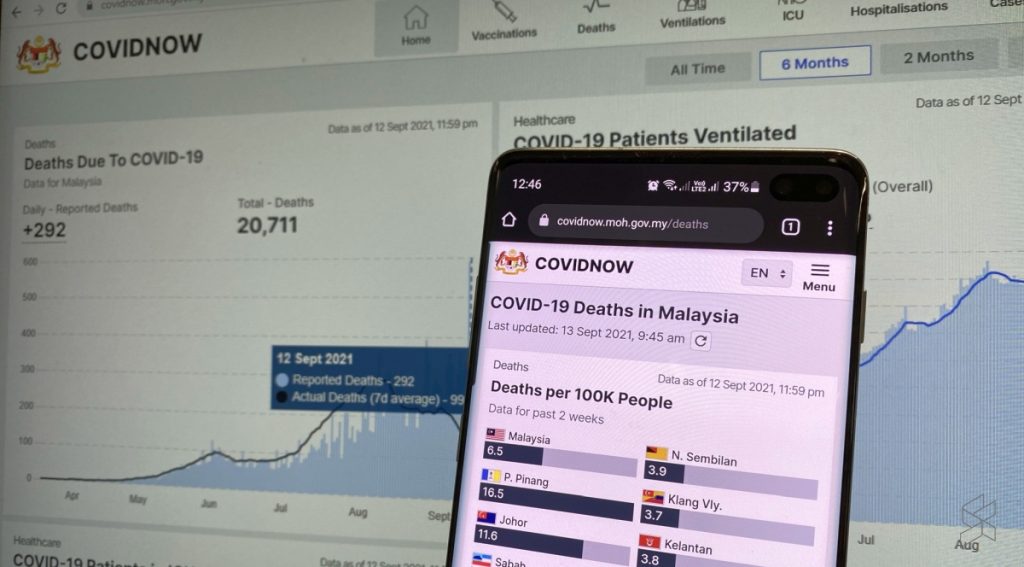
Reporting of true deaths for each day will help provide a clearer picture of the COVID-19 fatalities in Malaysia. This is important to analyse the vaccine effectiveness and case fatality rate on a daily basis. According to Khairy, his ministry hopes to see a reduction in the next couple of weeks once they clear the backlog on deaths registered.
At the moment, the general public can view the COVID-19 death linelist on Github which contains the actual date of death as well as the age, comorbidity and vaccination status, vaccination date, and even type of vaccine administered. At the time of writing, the linelist contains 18,802 records from the start of the pandemic until up to 6th September 2021. Based on the open data, 922 fully vaccinated individuals (less than 5% of total deaths) have died due to COVID-19. From this figure, 80% of them had comorbidities and over 80% are aged 60 years old and above.
Current limitations
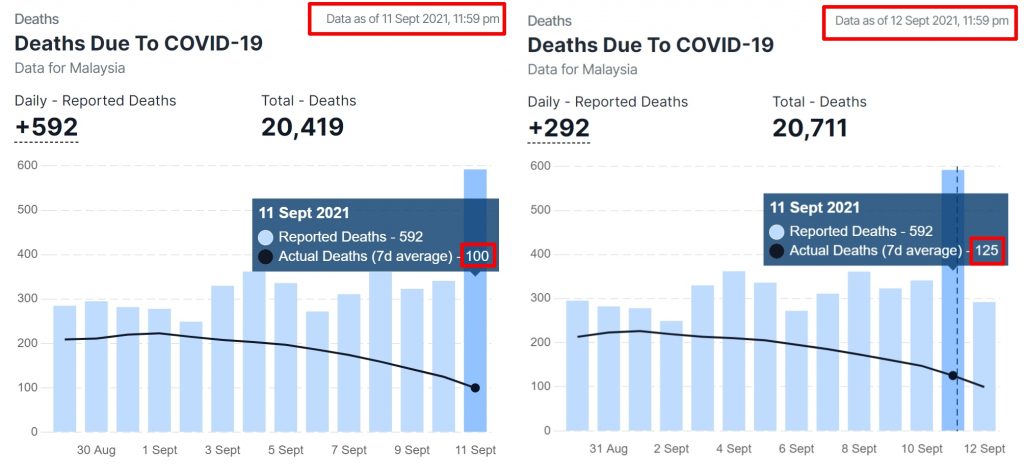
The data displayed on the CovidNow website is dynamic and will be updated daily at midnight. Because of the time required to confirm COVID-19 deaths, the number of actual deaths on a 7-day average may increase over time.
On 12th September, the 7-day average for actual deaths recorded for 11 September was 100. However, this figure increased to 125 on 13th September. The 7-day average will continue to increase until all backlog cases are cleared.
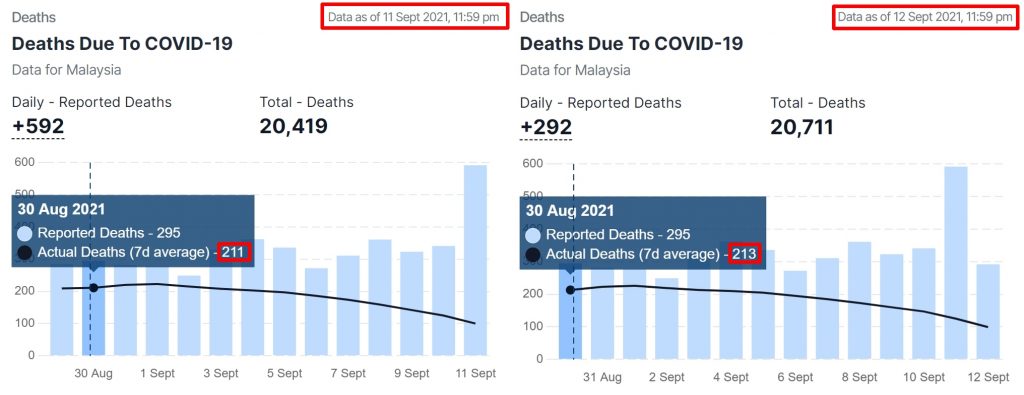
Similarly, the number of actual deaths from a few weeks ago may increase if additional deaths were recently confirmed to be due to COVID. On 12th September, COVIDNow had shown 211 actual deaths (7-day average) for 30th August, but it has increased to 213 today.
How do we intrepret this data?
Looking solely at the latest 7-day average may give the impression that the current number of deaths is low but the data is actually incomplete due to backlogs. Based on this limitation, it may take days or weeks for all deaths to be confirmed.
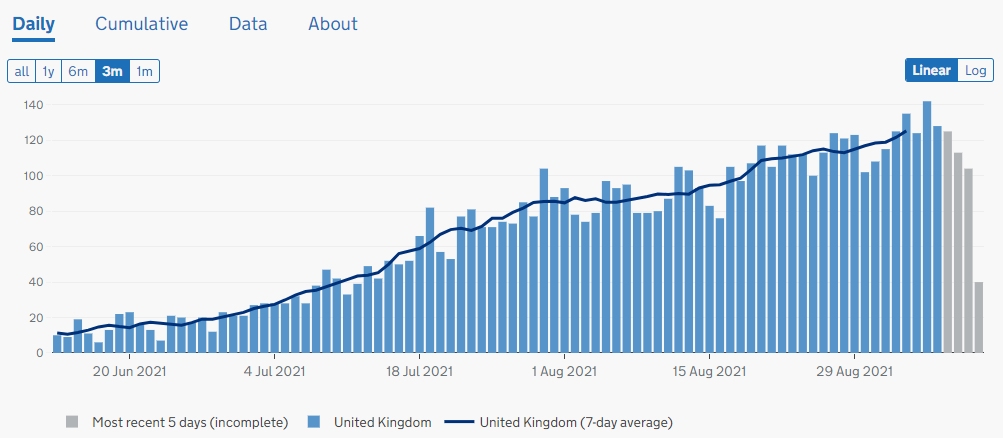
Malaysia isn’t the only country to use the 7-day average measurement. The United Kingdom is using it too but their dashboard has made it clear that the most recent 5 days are incomplete. The incomplete days in their graph are also highlighted in grey.
So how do we know if the trend of deaths is going up or going down? It all depends on how many backlog cases are there and how much time it takes for MOH to normalise the data. If a significant chunk of the backlogs can be cleared within a week, looking at the 7-day average of the previous week could be a better indicator. On 5th September, the current 7-day average is 205 deaths per day.
Based on the accumulative death recorded on a daily basis, Malaysia has recorded 2,536 COVID-19 deaths between 5th to 11th September which is an average of 362 deaths per day. Backlogs or not, the average number of deaths recorded is still a concern as it is higher than last month. Malaysia recorded 7,640 deaths in August which is an average of 246.45 deaths per day.
Dr Khor SK has provided a couple of suggestions to prevent unnecessary misunderstanding with the new reporting method. This includes a clear breakdown of actual deaths on the date and the number of backlog deaths reported since a specific date. He also suggested revealing the number of “deaths with COVID” alongside “deaths due to COVID” which could be a good way to address concerns that some deaths among positive patients were not reported.
592 deaths in a day? That’s not true.
— Dr Khor SK (@DrKhorSK) September 12, 2021
Here’s an analysis and two suggestions to improve. pic.twitter.com/yKrzgwczjW
Other metrics to consider
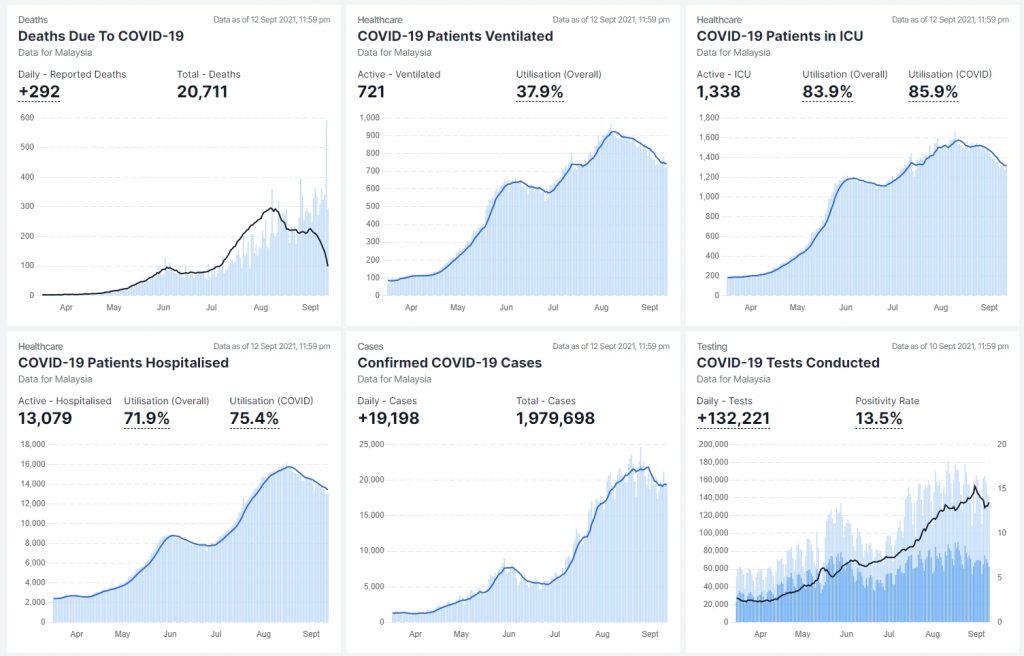
Besides looking at the number of deaths, there are other metrics to consider when evaluating Malaysia’s COVID-19 pandemic situation. This includes active cases, especially patients in hospital, ICU, and patients that require ventilators. With half of the country’s population fully vaccinated, Malaysia is starting to see a decline in hospital utilisation and ICU cases. In addition, 98% of new cases reported daily are classified as category 1 and 2 where individuals exhibit little or no symptoms.
[ IMAGE SOURCE ]
0 comments :
Post a Comment